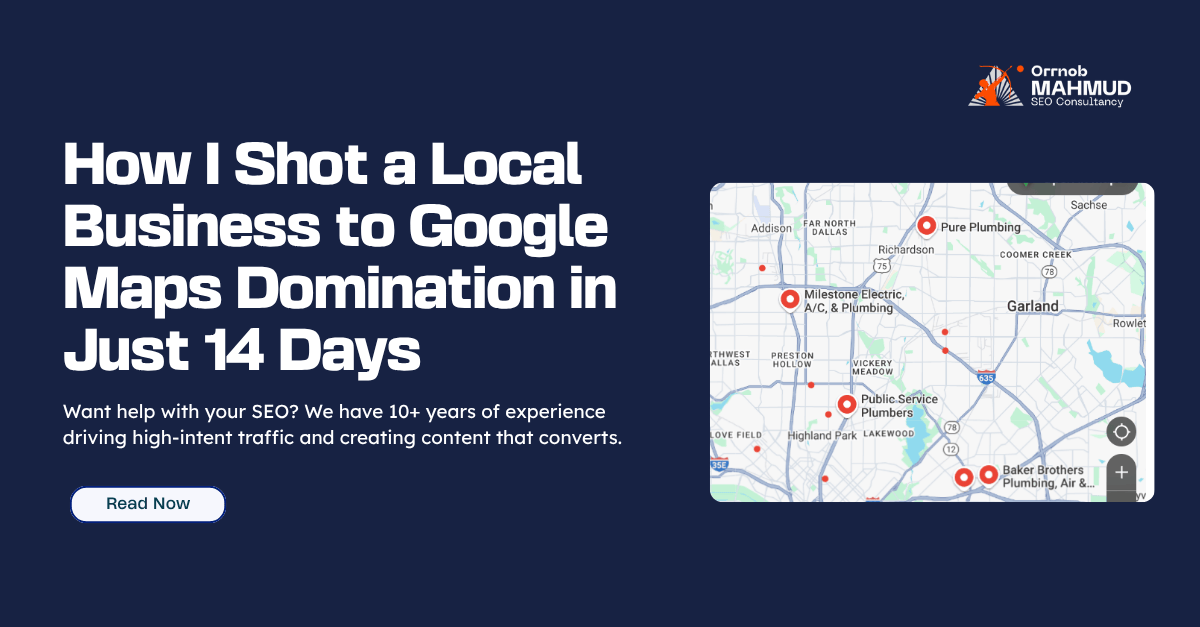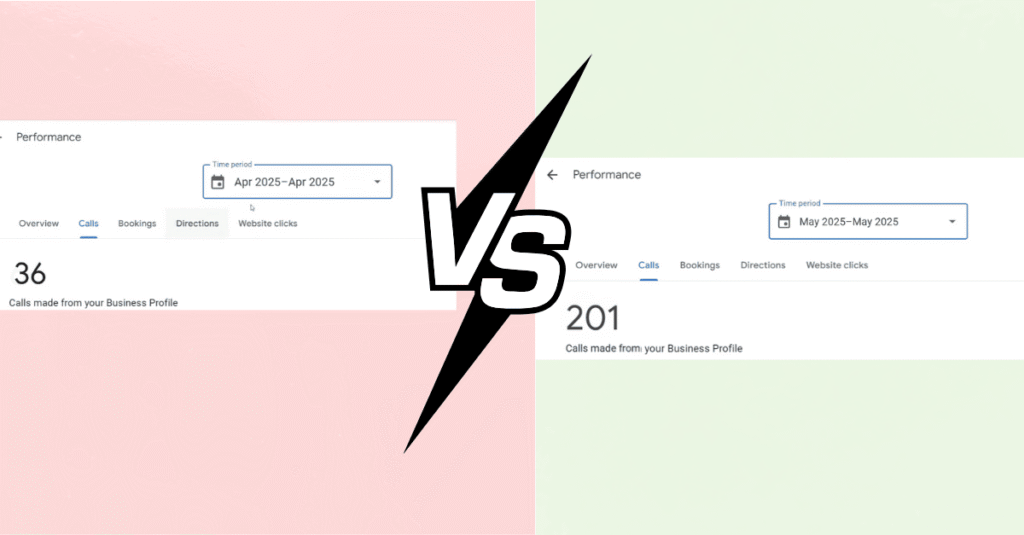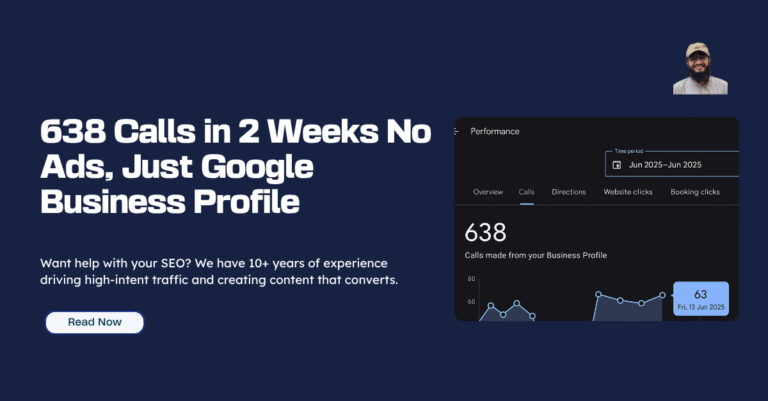How I Shot a Local Business to Google Maps Domination in Just 14 Days

Alright, let’s talk real. How many times have you heard the typical SEO agency line, “It takes six months to see results”? Honestly, if I had a Taka for every time I heard that, I’d probably be retired on a private island somewhere.
But here’s the truth: I just ranked a local plumber in the top two on Google Maps in a mere 14 days. Yes, you read that right – two weeks. Not position 20, not position 10. Position TWO. And trust me, that phone started ringing off the hook like crazy.

No complicated blogging. No outrageous ad spend. Just a system that literally stopped a $2,000/month client from jumping ship after a single month of “traditional” SEO. And believe me, this works even in super competitive markets.
Since 2016, I’ve been knee-deep in the SEO agency game, I’ve seen it all, and more importantly, I’ve helped countless business owners not just retain clients longer but grow their businesses faster, all thanks to actionable systems like the one I’m about to spill.
The Make-or-Break Moment: When “SEO Takes Time” Wasn’t an Option
Let me rewind a bit and show you exactly where this all started and why we had to move with lightning speed to save this client.
Last month, I got a call from a no-nonsense, old-school plumber in Plano, Texas. His words, delivered with a gruffness that reminded me of a pirate (no idea why!), were direct: “I’ve been paying for a month of SEO, and my phone isn’t ringing. Either make it ring, or I’m out.”
This wasn’t just about keeping a $1200 a month client. This was about five employees whose livelihoods depended on this business. Truck payments were looming. Every single day without new customers brought him closer to having to let people go. The stakes were incredibly real, and there was no room for the usual “SEO takes time” excuses. Ad spend was out of the question too – we had to make this work with pure, unadulterated SEO power.
When he first came on board on January 19th, his Google Business Profile (GBP) was averaging a dismal position 20+. In the world of local search, that’s essentially being invisible. After our first month of “traditional” SEO, we nudged him to position 17.5. We optimized his GBP, ironed out some technical kinks, and laid out a content plan. For most agencies, that’s decent progress in a month. But for this client? He didn’t care about steady improvement. He wanted his phone ringing. Now.
The Brutal Truth About Local SEO (That Most Agencies Ignore)
Here’s the harsh reality that most SEO agencies just don’t want to admit: traditional SEO tactics often fall flat for local clients. Those weekly blog posts, supposedly building authority? They’re doing absolutely nothing to get your local clients actual phone calls.
We had to do something radically different. We had to go beyond what most agencies are even willing to consider. And that meant truly grasping a critical concept about local SEO that almost everyone else misses.
There are exactly three core components you need to absolutely nail for this strategy to deliver real results. I’m going to walk you through each one in detail.
But first, let me ask you: Do you know the single biggest mistake most agencies make with local SEO?
They focus on the wrong target entirely.
Think about it. When someone searches for “plumber near me” or “plumber Houston,” what does Google show you? A map, right? With three businesses prominently displayed at the top. These aren’t websites; they are Google Business Profiles. And a staggering 60-70% of all clicks, traffic, and calls go to one of those top three map listings.
If you’re not in that “map pack” – if you’re ranked number four or worse – you are, effectively, invisible.
Most agencies obsess over ranking the website for keywords like “best plumber in Houston” or “affordable plumbing repair.” But even if you somehow manage to rank number one organically, you’re still below the map pack. You’re playing for a measly 30% of the clicks, while the lion’s share has already been snapped up by the map listings.
This means that every single page on your local client’s website exists for one reason and one reason only: to rank their GBP higher in the map pack. We’re not trying to rank URLs for their own sake, or individual articles just to get “readers.” We’re building strong signals to help Google understand and trust that GBP enough to showcase it in the precious map section.
So, want to know why so many local businesses get abysmal results from SEO? Their agencies proudly display traffic graphs surging while the phone remains stubbornly silent. That’s because they’re bringing in readers from all over the country looking for information, not locals actively looking for services.
Let’s dive into the core of my system.
Layer 1: The Bulletproof Google Business Profile (GBP) Optimization
This is your foundation. Your bedrock. The first step for any new local client. Most businesses barely scratch the surface when filling out their GBP. But a perfectly optimized GBP can dramatically boost your rankings.
When we first audited this plumber’s GBP, we found what we typically see: only one category listed. Did you know Google allows up to ten categories? Leaving those blank is like leaving money on the table.
So, first order of business: we added four to five highly relevant categories. And yes, a smart ChatGPT prompt helped us ensure we were hitting the mark every single time. (If you want this prompt and others, you know where to find me – but you can also pause here and grab them!)
Next, we went deep. Over 30 specific services were added to his GBP. Again, AI helped us brainstorm and structure these. And finally, we filled out every single box: business description, hours, attributes, everything.
This foundational optimization alone was what moved him from position 20+ to 17.5. It was progress, but we needed a quantum leap.
Layer 2: The Website Structure That Speaks Google’s Language (Not Yours!)
This is where things get interesting. His website simply wasn’t communicating with Google in the way local search demands. Most web designers build local business sites all wrong. They prioritize pretty images, generic service pages, and maybe a few testimonials.
But Google doesn’t care about “pretty.” It cares about relevance and trust.
The simple, yet perfectly structured site I’m about to break down will effortlessly outrank a fancy, $10,000 brochure site.
The previous SEO agency had this plumber churning out blog post after blog post about generic “plumbing tips.” Content that might rank nationally but did absolutely nothing for local visibility.
So, what does Google’s local algorithm actually want to see? Something completely different from the norm. And if you give it what it wants, you’re almost guaranteed to see a massive rank increase.
Google looks at one crucial thing most SEOs miss: Does your website perfectly match what you say in your Google listing? If there’s a mismatch, Google thinks your business might be dodgy. If they align perfectly, Google starts seeing you as legitimate and trustworthy.
Our solution? We completely restructured his website to exactly mirror his GBP.
- Homepage Revamp: Instead of a generic “Home” title tag, we used his primary GBP category + city: “Professional Plumber in Plano, 24/7 Emergency Service.”
- H2 Sections for Secondary Categories: We used each GBP secondary category as an H2 section on the homepage, with a few hundred words about each. For “Drainage Service,” we talked specifically about “drain cleaning in Plano.” For “Gas Installation Service,” we discussed city permit requirements and local gas line regulations. It’s like explicitly telling Google, “Yes, this business genuinely offers exactly what its GBP claims, and it does so in this specific location!”
But we still had a massive hurdle. Even with this improved homepage, the plumber was nowhere near the top three for consistent calls. Why? His website had a mere five service pages. To Google’s algorithm, he looked like a small, limited operation compared to his competitors who had more comprehensive, authoritative websites.
We needed a complete content hierarchy that, once again, perfectly mirrored his Google Business Profile.
- Dedicated Pages for Secondary Categories: For each secondary GBP category, we created a dedicated page with a URL structure including both the category and location. E.g.,
domain.com/heatingcontractor-plano. These pages covered different types of water heaters he installed in specific Plano neighborhoods. - Individual Service Pages: Instead of one generic “Services” page, we built specific, in-depth pages for “toilet repair,” “sewer line replacement,” “water heater installation,” and more. Every single one had the service and city name in the title tag, H1 tag, and first paragraph.
With five GBP categories and 30 services, this meant building roughly a 40-page website structure. And it did something incredibly powerful: it told Google that this plumber was a comprehensive authority in his service area. It built both geographic relevance (mentioning specific neighborhoods) and topical relevance (covering every service in detail), all perfectly aligned with his GBP.
Quick question: What do you think happens when a business suddenly adds 40 new pages to their website? Many might assume Google would get suspicious. But structured correctly, Google trusts the site more.
Now, the seemingly impossible challenge: creating 40 pages of unique, locally focused content in a matter of days, without shelling out thousands for copywriters. This is where most agencies hit a brick wall.
We needed content that was:
- Unique, not templated.
- Locally specific, mentioning neighborhoods and city details.
- High-quality enough to satisfy both users and Google.
- Immediate.
The solution, which you might be expecting: a very specific approach to AI content creation.
We used a highly structured ChatGPT prompt. We didn’t just say “write about plumbing.” We specified the exact category, service, and city. We instructed it to include mentions of specific neighborhoods. We told it to write from the perspective of a local expert who truly knows the area.
The result? Content that reads like it was written by someone who actually works in that specific location. Not generic “we service all areas” drivel, but specific, “here’s how we handle water heater replacement in this neighborhood of Plano” content.
With this prompt, we built out the entire 40-page structure in a single afternoon. A few small edits for personalization and specific local references, and honestly, 90% of the work was done by AI.
“But Orrnob, won’t Google detect and penalize AI-generated content?”
Here’s the truth most people don’t understand: Google doesn’t care if content is written by AI or humans. It cares if the content is helpful and trustworthy. The reason most AI content fails is because it’s generic, templated, and frankly, garbage. But when you create locally specific AI content with the right prompt, and back it with quality links (more on this in a bit!), Google rewards it. We’ve tested this across dozens and dozens of clients.
Layer 3: The Critical Technical & Trust Signals (The Unsung Heroes)
We had fantastic content, a perfect website structure, and an optimized GBP. We were expecting to shoot straight to the top three. But when we checked, he was still stuck at position 10. Something was missing.
Google needs to verify that the website and the Google Business Profile actually belong to the same business. Without this verification, all our hard work is wasted.
There are three specific technical signals Google looks for to verify a business. Most SEO agencies only implement one.
- Schema Markup: We implemented local business schema markup on the homepage, matching his GBP information character for character. This structured data is like handing Google a business card with all the exact same information as the GBP. The prompt for this is incredibly simple, but powerful.
- Direct Map Embedding: We embedded his Google Maps profile directly on the contact page. This creates another strong signal connecting the website to that exact GBP.
- Consistent NAP (Name, Address, Phone Number) & Citations: This is something even experienced SEOs often miss. Your business name, address, and phone number (NAP) need to be in the exact same format across your website, your GBP, and any external citations. Don’t worry about updating old listings if you’re not sure they’re consistent – just create new, perfectly consistent ones.
After implementing all these technical elements, we saw another jump. Position 8. Still not in the top three where the phone would start ringing consistently. We were so close, but we needed one final push.
The Final Piece of the Puzzle: External Verification (The Non-Negotiable)
At this point, we had the perfect foundation. The content was spot on. The technical elements were locked in. But Google still wasn’t fully convinced this business deserved to be in the top three. Why? Because anyone can create a website with good content. What Google truly needs, and what most local businesses completely miss, is external verification that a business is legitimate and trustworthy.
This is the final piece of the puzzle, the one so many people skip, thinking it’s too expensive or time-consuming. But this is what separates businesses stuck on page two from those dominating the map pack.
Every single page on the site needed at least one quality external link pointing to it.
This is not optional. This is mandatory. Google uses external links as a quality verification signal, especially for AI-generated content. Without links, even the best content looks suspicious to Google. But with quality links, that same content becomes authoritative and trustworthy.
We sourced high-quality links for about $35 per link – the same links my agency uses for all our clients.
- For the homepage, we got him listed in the local Chamber of Commerce. Worth every penny for the local authority it provides.
- We also ensured he had complete social profiles, matching his business name exactly.
- And for that extra local punch, we even sponsored a local youth sports team.
Was it worth the investment? Absolutely.
Within 14 days of implementing this complete system, the plumber’s GBP rocketed from position 17.5 to position 2.35. Our impatient plumber became our biggest advocate, and that $2,000/month client was not only saved, but he’s now referred three other business owners who have since become clients. That’s the power of real, measurable results.
So, there you have it. You now know exactly how to take any local business from invisible to the top three on Google Maps in just 14 days. This works in about 90% of local markets because the competition simply isn’t doing it. They’re either doing nothing, or they’re writing random blog posts that have zero impact on local rankings.
Your Next Step: Local SEO Link Building
We didn’t just stop at the website and technical elements. As I mentioned, joining the Dallas and Plano Chambers of Commerce, sponsoring a youth softball league, and using a special prompt to find even more quality local links were key to this success story.
Without these specific types of links, the entire strategy I just showed you won’t work at all. This is the difference between a 14-day ranking transformation and waiting six months for mediocre results.
Ready to complete the full strategy and truly dominate local search?

